He was a shaper and the son of a shaper.
Khleber Miller Van Zandt was born in Tennessee on November 7, 1836 to Isaac Van Zandt and Frances Cooke Lipscomb Van Zandt and came to the Republic of Texas with his family at age three. The family settled in what would become Harrison County (Marshall).
 Father Isaac Van Zandt donated land for and helped to survey and lay out the town of Marshall about 1842. He named Marshall in honor of Supreme Court Chief Justice John Marshall. Van Zandt County is named for Isaac. (Photo from Wikipedia.)
Father Isaac Van Zandt donated land for and helped to survey and lay out the town of Marshall about 1842. He named Marshall in honor of Supreme Court Chief Justice John Marshall. Van Zandt County is named for Isaac. (Photo from Wikipedia.)
 Isaac Van Zandt would become one of the shapers of Texas: As Sam Houston‘s chargé d’affairs to the United States during the latter days of the republic, Van Zandt, with his family, was in Washington, where he negotiated the treaty of annexation of Texas. (James Pinckney Henderson would be elected the new state’s first governor in 1845.) This clip of just part of the treaty is from the Yazoo City Whig of Mississippi.
Isaac Van Zandt would become one of the shapers of Texas: As Sam Houston‘s chargé d’affairs to the United States during the latter days of the republic, Van Zandt, with his family, was in Washington, where he negotiated the treaty of annexation of Texas. (James Pinckney Henderson would be elected the new state’s first governor in 1845.) This clip of just part of the treaty is from the Yazoo City Whig of Mississippi.

Likewise, son Khleber would become one of the shapers of Fort Worth: He was a founder of one of Fort Worth’s first banks and was instrumental in bringing two railroads to town: the Texas & Pacific in 1876 and the Fort Worth & Denver City in 1882. He served in the Thirteenth Texas Legislature and at the Constitutional Convention of 1875.
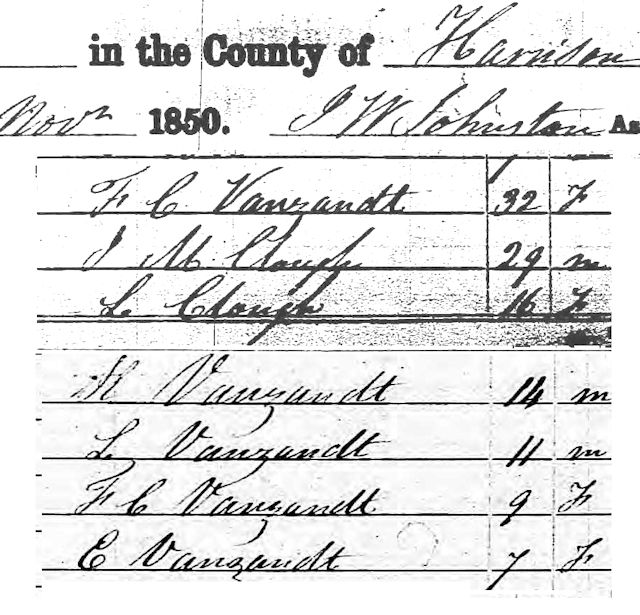 Father Isaac died in 1847. In 1850 his widow Frances Cooke Van Zandt and children were again living in Harrison County. Khleber was fourteen; brother Lycurgus was eleven; sister Frances Cooke was nine. (The Cloughs were related by marriage.)
Father Isaac died in 1847. In 1850 his widow Frances Cooke Van Zandt and children were again living in Harrison County. Khleber was fourteen; brother Lycurgus was eleven; sister Frances Cooke was nine. (The Cloughs were related by marriage.)
After attaining the rank of major in the Confederate army, after the war Khleber Van Zandt moved his family from Harrison County to Fort Worth. Fort Worth, he recalled, presented “a sad and gloomy picture.” The courthouse did not have a roof. The war had reduced the city’s population to only two hundred. Nonetheless, Van Zandt had faith. He bought the city block where Sundance Square Plaza is today.
 He opened a “mercantile store” across from the courthouse. In 1874 he and three partners (Thomas Tidball, Major James Jones Jarvis, and John Peter Smith) formed Tidball, Van Zandt and Company, a bank that was the forerunner of Fort Worth National Bank, in a wood-frame building measuring fifteen by thirty feet near the courthouse. And in 1876 Van Zandt was largely responsible for bringing the Texas & Pacific railroad to town. He donated land for the T&P reservation and was president of the Tarrant County Construction Company, which was formed to pay a contractor to grade the T&P roadbed from Eagle Ford west of Dallas to Fort Worth and to install bridges and culverts for the tracks.
He opened a “mercantile store” across from the courthouse. In 1874 he and three partners (Thomas Tidball, Major James Jones Jarvis, and John Peter Smith) formed Tidball, Van Zandt and Company, a bank that was the forerunner of Fort Worth National Bank, in a wood-frame building measuring fifteen by thirty feet near the courthouse. And in 1876 Van Zandt was largely responsible for bringing the Texas & Pacific railroad to town. He donated land for the T&P reservation and was president of the Tarrant County Construction Company, which was formed to pay a contractor to grade the T&P roadbed from Eagle Ford west of Dallas to Fort Worth and to install bridges and culverts for the tracks.

In his autobiography, Force Without Fanfare, Van Zandt recalled that in about 1880 he and his family lived in a five-room cottage on a farm where Trinity Park now is—two miles west of his bank, then located downtown at 1st and Main streets. This banker’s daily commute to the office was typical of his times: He rode to work on horseback, which meant he had to cross the Trinity River. There were no bridges over that stretch of the river then, but the Clear Fork, as today, was shallow and limestone bottomed in places and could usually be forded. Unless, that is, the river was running high, as it was one morning after a heavy rain. Van Zandt rode down to the river on his way to his bank and saw that he could not cross.
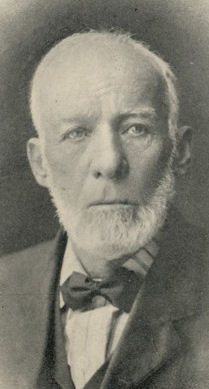
But Van Zandt saw Major Jarvis, a partner in the bank, hailing him on horseback on the opposite side of the river. Jarvis hollered across the swollen river to Van Zandt, saying a customer had come into the bank to make a withdrawal. But the bank’s assets were kept in a safe. Which was locked. And only two partners knew the combination—Van Zandt and Thomas Tidball. And Tidball was out of town.
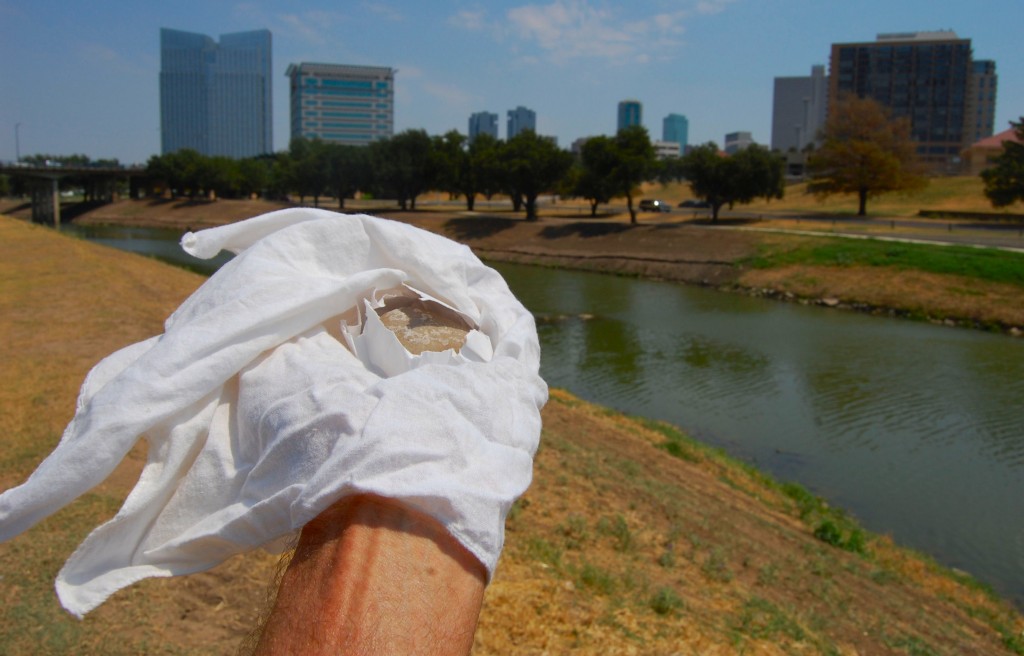
So, while Jarvis waited on the other side of the river, Van Zandt wrote the combination on a piece of paper, wrapped the paper around a rock, wrapped his handkerchief about the paper and rock, and threw the safe combination over the river to Jarvis.
Jarvis rode back to the bank.
The safe was opened.
The withdrawal was made.
Customer service, nineteenth-century style.
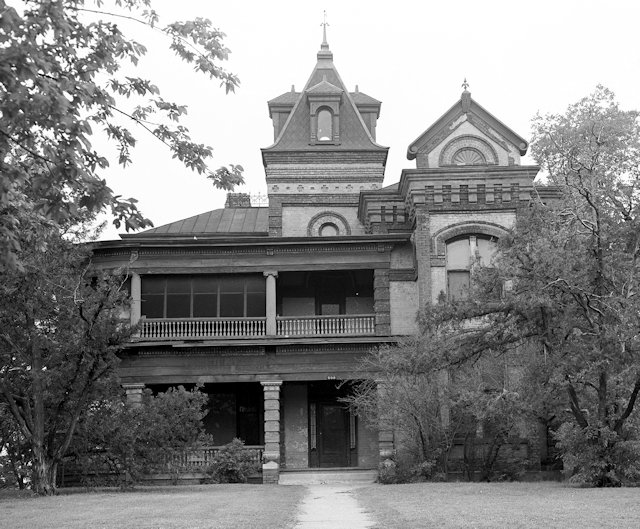
Khleber Miller Van Zandt would prosper, marry three times (his first and second wives were sisters), sire five children in each marriage, and eventually live in a grand home at 800 Penn Street on Quality Hill. He would be a teacher or superintendent of Sunday school at First Christian Church more than a half-century. (Photo from University of Texas at Arlington Libraries.)
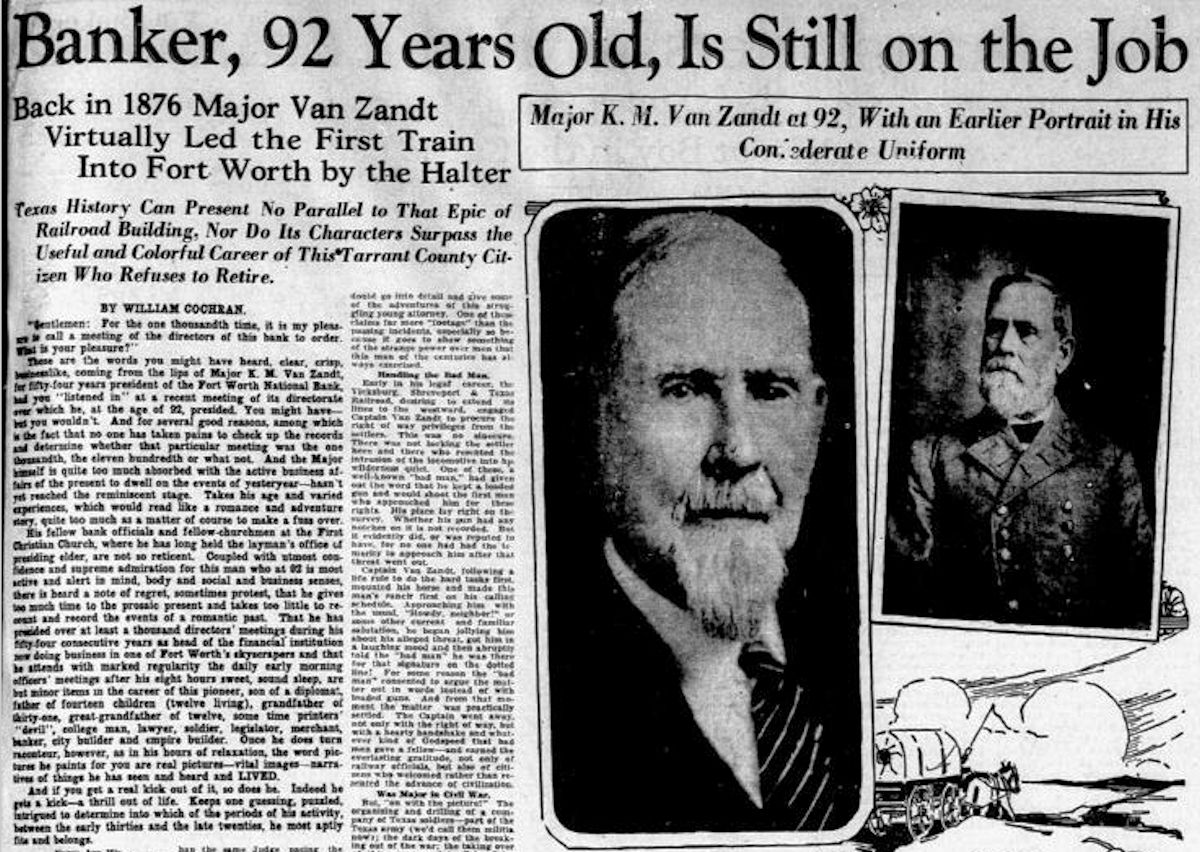 In 1929 the Dallas Morning News printed a review of Van Zandt’s life and his contributions to Fort Worth, saying that he “virtually led the first train into Fort Worth by the halter.”
In 1929 the Dallas Morning News printed a review of Van Zandt’s life and his contributions to Fort Worth, saying that he “virtually led the first train into Fort Worth by the halter.”
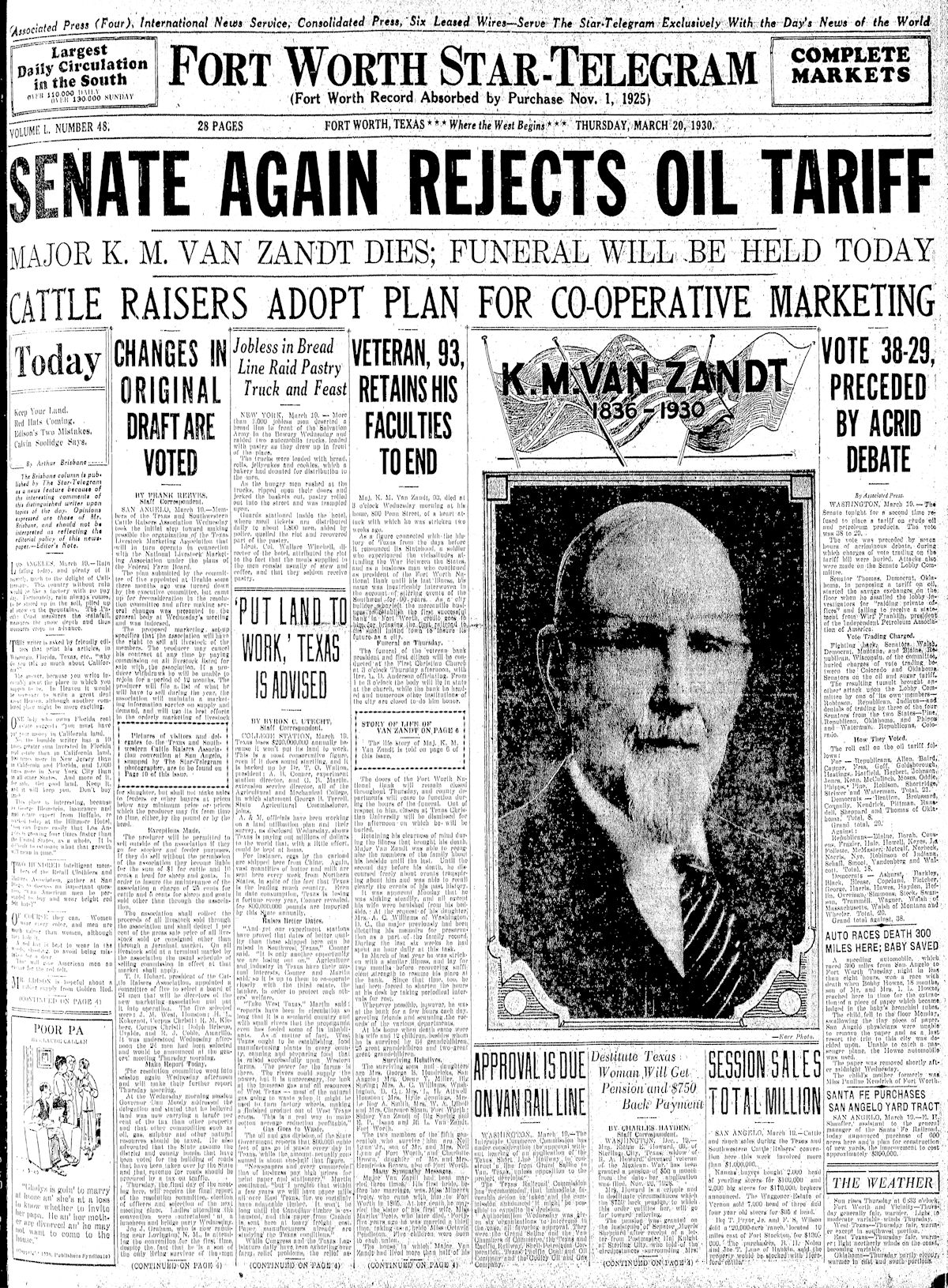 But thirteen months later, on March 19, 1930, Khleber Miller Van Zandt was dead at age ninety-three. The Star-Telegram eulogized him as “the grand old man of Fort Worth” and Fort Worth’s “first citizen,” proclaimed that “The story of Major K. M. Van Zandt . . . is the story of Fort Worth, the story of Texas and the Confederacy.” When Van Zandt died he was in his forty-sixth year as president of the bank he had helped to found in 1874. And he was still going in to the office at 8:15 each morning.
But thirteen months later, on March 19, 1930, Khleber Miller Van Zandt was dead at age ninety-three. The Star-Telegram eulogized him as “the grand old man of Fort Worth” and Fort Worth’s “first citizen,” proclaimed that “The story of Major K. M. Van Zandt . . . is the story of Fort Worth, the story of Texas and the Confederacy.” When Van Zandt died he was in his forty-sixth year as president of the bank he had helped to found in 1874. And he was still going in to the office at 8:15 each morning.
But no longer on horseback.
 Khleber Miller Van Zandt is buried in Oakwood Cemetery.
Khleber Miller Van Zandt is buried in Oakwood Cemetery.
Other posts about Van Zandt:
Van Zandt: Father and Son, State and City (Part 1)
From Adams’s Beaver Hat to Dylan’s Coffee Table
Blue and Gray: “Best of Friends . . . As If We Had Fought Side by Side”
Hotel Block: From “Sad and Gloomy” to the Golden Goddess
Buttons and Bones: The Life, Death, and 3 Burials of 2 Confederate Generals






Thank you for preserving this! I am a direct descendant of K.M. and I am very happy to see this, he was a great man and I am very proud to have him as my ancestor.
Sincerely,
Sara VanZandt
Thank you, Sara. One of the biggest names in FW history without a doubt. If I could have ghosts as guests for dinner, he would be one of the first I would invite. He probably appears in my blog more than anyone else with the possible exception of Amon Carter.
This is my great X5 grandfather, I have learned a lot from this post and love it. When I was a kid I was in my grandmothers basement (Her maiden name was (Vandzandt) and found a letter written by KM’s father Issac Van Zandt in 1832 to his wife, so awesome!!
James, from Isaac to Khleber to Townes, what a legacy the Van Zandt family has given us.
Mike - I sure do enjoy and appreciate your columns! While everybody thinks Van Zandt started what became FWNB, it was apparently Tidball and Wilson, then KVZ and JP Smith and JJ Jarvis bought in. See:
http://fortworthtexas.gov/flashback/2012/12/fort-worth-flashback-fwnb-collection-captures-our-citys-history/
Thanks, Dawn. I have made that correction.
Hello.
When Van Zandt served in the 13th State Legislature he helped pass an act that led to the incorporation of Fort Worth. Does anybody the name of the act. Thank you.
Rene, Paddock’s history, Van Zandt’s autobiography, Cranz’s thesis The Impact of a Father and Son on Texas: Isaac Van Zandt and Khleber Miller Van Zandt, and Knight’s Outpost refer to the passage of the bill by the 13th legislature in 1873 but not by the bill’s name.
The T&P line was extended over from Eagle Ford. I’d like to know what is there now and if it is possible to get to (by automobile) the actual place of the Trinity River crossing; because, I would like to go there one day and just, well, just be there and think about the history. Love - Love - Love your reporting!
Thanks, Bob. I am not sure the tracks actually crossed the river at Eagle Ford. Laying track west stopped at Eagle Ford in 1873. Looking at maps back to 1891, the tracks crossed the river where they do today—just west of downtown Dallas. The tracks do cross Mountain Creek, a southern tributary of the Trinity, near Eagle Ford. A north-south road forded the river north of Singleton Boulevard about where Loop 12 crosses the river today. Lots of history in that gritty area. Lots of fossils exposed in limestone in the river bottom. Also ties to Bonnie and Clyde.